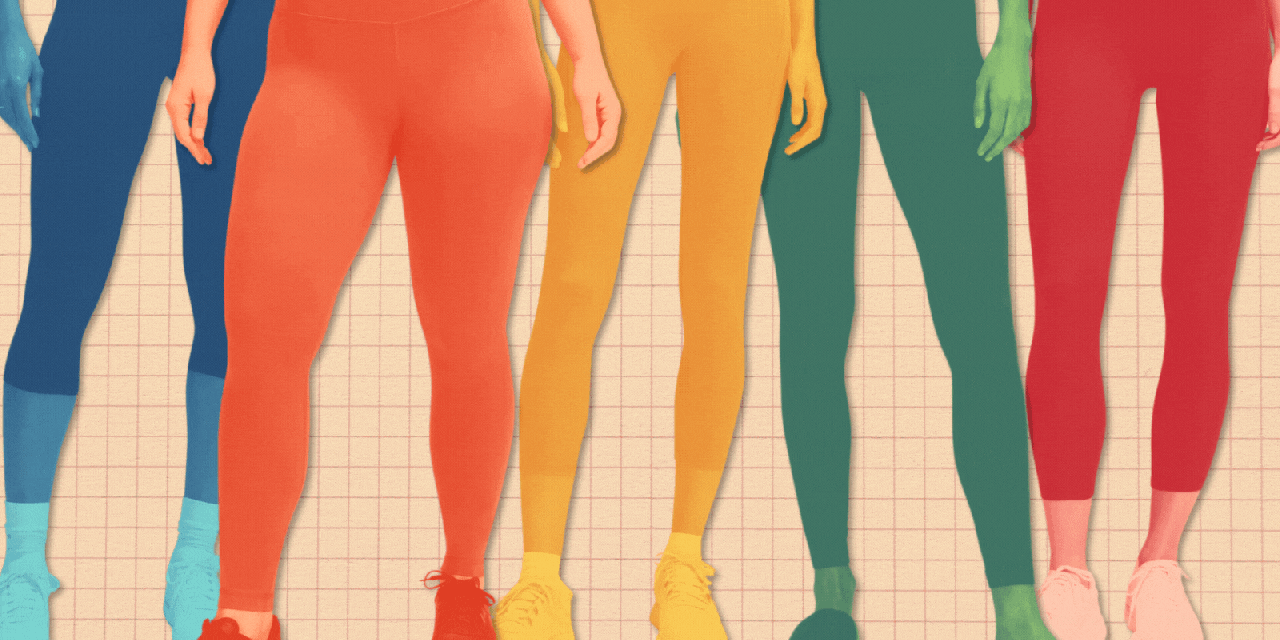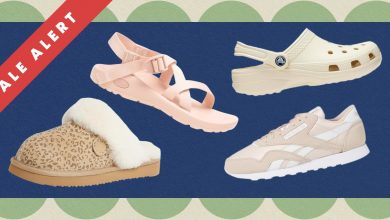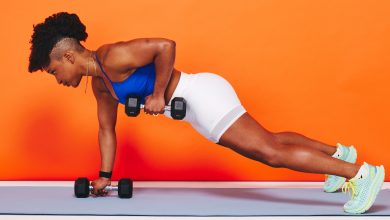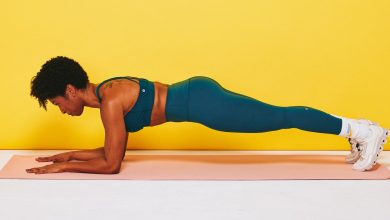Do Lululemon’s Leggings Seem…Smaller to You?

A specter is haunting Lululemon shoppers—the specter of tiny leggings. At least that’s what some of the brand’s adult customers seem to believe. A thread on the r/lululemon subreddit from March, bluntly titled “Has their clothing gotten smaller or am I just getting fatter lol,” garnered hundreds of comments from people convinced that something about the garments has changed.
“Boy am I relieved to see it’s not just me that noticed this!” one Redditor wrote in response. “I’ve been buying a 4 in Aligns and 6 in bras/tanks forever. Now I’m a 6 in Aligns and an 8 or 10 in bras and tanks. The Align shorts just don’t fit the same anymore even when they’re not double lined. They had to have changed the fabric or something.”
“Not just you!!!!!” another said. “It’s seriously messing with my head. This is relieving to read. I’ve lost a fair amount of weight and figured I was ready to size down in Wunder Trains since mine are falling down on me. Nope.”
Others chimed in that although they’d stayed the same size in other clothing, remained the same weight, or even gone down in regular pants sizes, the number on their Lululemon garments continued to rise.
One woman who responded to the Reddit thread, Stella, tells SELF she’s been shopping at Lululemon since she was 13 years old. Now 28, she says she owns around 35 articles of Lulu clothing, mostly leggings, tops, and shorts—but said she noticed a change in the brand’s garments over the past 6 to 10 years, with an even bigger shift since 2020. “I find the sizing discrepancies right now are major between different legging models,” she says. “A 6 in Align could be a 14 in another legging. The disparity makes me feel frustrated—it’s much harder to shop at Lululemon now than it was before the pandemic.”
Maddie Ball, a 29-year-old living in San Francisco, tells SELF another sizing issue showed up for her in an even less predictable way when she tried to resell a pair of the Wunder Under high-rise leggings on Poshmark in September 2023. “The buyer thought they were fake,” she tells SELF.
I reviewed screenshots of the unhappy customer’s complaint, and…whew: “These ‘size 6’ leggings will not even go past my knee they are so small,” the person wrote. “Also as you can see in the picture the texture of the leggings is grainy, I have a pair of size 6 Lululemon leggings that I bought from Lululemon which is made out of buttery soft materials with no texture.” Ball says she suspects the leggings her dissatisfied buyer owned were from a different line of Lulu clothing than the ones she was selling. Still, she says she ultimately canceled the transaction because, in fairness, “this pair did seem especially small.”
On that note, Stella also says she feels that the quality of Lulu’s activewear has changed for the worse. “I own shorts, tops, leggings, headbands, purses, yoga mats, multiple other types of accessories, and I feel the quality for the clothing pieces themselves, especially the leggings, has changed to the extreme,” she says. “My first pair of leggings, purchased over 15 years ago, are still in mint condition with nothing wrong with them despite YEARS of use. Lulu these days simply cannot compare.”
It’s also worth noting that Lulu has tussled with its fans before: In 2013, the company recalled nearly 17% of its leggings after customers complained for months that the bottoms were see-through and reported that some store employees asked them to bend over in order to verify the problem. (At one point during the fiasco, Lululemon founder Chip Wilson put the onus for the quality issue on customers, saying that “some women’s bodies don’t work for the pants. It’s really about the rubbing through the thighs, how much pressure is there over a period of time.”) We’re living at a time when consumers have become increasingly suspicious of the overall quality of what they’re buying in general.
And now athleisure-related conspiracies are spreading among Lulu lovers. “I thought this too the other day while in-store,” user @desnyr wrote on the Reddit thread. “My theory is I think it could be to expand their sizing ranges down into the preteens where it is popular right now.” It received 228 upvotes and is currently the top comment.
It’s not hard to find examples of the newest generation of Lululemon customers—the athleisure counterpart to the so-called Sephora tween. Take one TikToker’s daughter’s first Lulu shopping spree, which the proud mother filmed and posted on the platform, and which has racked up more than 5 million views since January. “She was so excited. As soon as we walked in, her face lit up,” narrates Mom, over footage of her daughter beaming as she browses and chats excitedly with Lululemon employees. “You would think this girl has been in this store 20 times,” the woman continues. “She knew the names of the colors, and I was kind of shocked!”
That 10-year-old’s shopping spree is part of the Gen Z-eitgest. Despite its eye-popping price point (I cannot emphasize enough that my mom would never have shelled out for this stuff when I was a teen!) Lululemon is a hit on TikTok. The teens want the athleisure, and they want it bad.
If a butterfly can’t even flap its wings without causing some ripple in the fabric of history, surely a horde of youths with cash to burn and a voracious appetite for stretch fabrics has the potential to make a seismic impact—at least on Lululemon. So, is it true? Could Lululemon, by bestowing the numerical (and inconsistent) sizing of adulthood on its young customer base, be subliminally welcoming younger and younger shoppers into the fold instead of using overt ad campaigns? If that’s the case, there might be a totally unintended impact on its older customers.
Lululemon has stated publicly that it isn’t courting a teen audience, at least when it comes to advertising: In 2022, Forbes reported that some of the athleisure giant’s top executives told attendees at a strategy meeting that its marketing remained “age-agnostic,” versus catering directly to a younger crowd. (The Forbes story also linked to a 2015 New York Times interview with Lululemon founder Chip Wilson, where he described his muse for the brand: a single, 32-year-old, condo-owning professional woman named Ocean. Wilson stepped down as chairman of the board in 2013 and fully resigned from it in 2015.) Still, the brand is undeniably popular with young people—a 2022 poll of Gen Z shoppers found that Lululemon was the top brand of choice for teen girls from higher income households, and in 2023, the same poll found that the brand was the number two choice for all teen shoppers surveyed, second only to Nike. But in 2019, Lululemon announced it was shuttering Ivivva, the kids sportswear brand it launched in 2009.
So, what do the facts say? As I reported this story, the SELF staff attempted to do a little detective work. According to editor in chief (and unofficial leggings sleuth) Rachel Miller, the editorial team rifled through their drawers to see if they could clearly demonstrate that the newer leggings were smaller. “I have personally noticed a change in how my newer Lulu leggings fit compared to the ones I bought in the early 2010s and I have gone up a size as a result,” Miller says. “With that in mind, I asked my team, many of whom have been wearing Lululemon for years, to get out their older pairs and a measuring tape and see what they found.”
SELF fitness director Christa Sgobba measured Lulu leggings she got as a sample three years ago against a newer pair she bought, and found that the ones she purchased more recently were actually slightly larger.
Older Lululemon leggings (blue printed) vs. newer (black)
Christa Sgobba
Christa Sgobba
Christa Sgobba
“The new ones might be a hair bigger on the waist,” Sgobba says. But she has a hunch why she might have felt otherwise without the aid of a ruler: “The old ones do feel more comfy and the new ones feel more ‘held in.’ My guess is that they might not be cut differently, but they lose their compressive/stretch properties through washing, wear, and drying—the blue have been washed and worn A LOT, and the black probably washed less than 10 times—so the new ones feel ‘tighter’ since its compression material is at its finest.”
Other SELF folks, including Miller, also say that their newer pairs feel tighter throughout the legs—possibly due to a change in materials and cut, or because older pairs have stretched out over time—which they think may be playing a role in the overall feeling that the pants are smaller now. (Another Redditor posited something similar when posting photos of themself in their Wunder Unders of yore alongside a current pair.)
After our homespun analysis reached its end point, SELF reached out to Lululemon with a series of questions: When was the last time Lulu changed its sizing chart? How has it adapted its products to fit a growing teen customer base? Is it possible that washing and/or drying could lead to fabric deterioration that are making the leggings feel either bigger or smaller in size? Has anything else changed about its garments? What, if anything, does the brand have to say to folks who feel the clothing is no longer as high-quality as it used to be? Lululemon representatives didn’t respond to each question, but sent the following statement via email:
- “Over the past several years, lululemon has evolved its product assortment in several ways to create more choice for our guests, including expanding our size range; introducing new fabric technologies (SmoothCover, SenseKnit, Utilitech to name a few), silhouettes (Classic, Oversized, Slim), and specialized fits (Contour fit, increased range of bra cup and band sizing). We have also begun to introduce alpha-sized product options.
- While guests may size up in a slim fitting style because that feels best for them, they may choose to size down in a product that comes in an oversized fit.
- To support and empower our guests in their size selection, we provide resources to help find the fit that feels best for them in-store and online, including links to our size charts on all our online product pages and customized notes on product feedback that we’ve gathered from guest reviews.
- Feedback from our guests and ambassadors is integral in helping shape our product assortment and informing future opportunities to innovate new product solutions for guests’ unmet needs.”
Is this a smoking gun, a neat answer to the case of the shrinking workout gear? Not quite, but they do seem to affirm what a lot of Lululemon shoppers say they are experiencing: The brand doesn’t have a one-size-fits-you metric for measuring your clothes, and that’s a feature, not a bug. And the mention of new fabric technologies, silhouettes, and fits lends a bit more credence to the SELF staff’s hypothesis that differences in fabric and cut might be part of what longtime fans are picking up on.
Will this knowledge comfort customers who might remain convinced that something about their Lulu clothes is different? This reporter has a confession to make: Before writing this article, I had never shopped at Lululemon. (I usually work out at home, which means my athletic gear tends to give off more Adam Sandler than Ocean.) That doesn’t mean, however, that I haven’t experienced sizing woes in general—that creeping anxiety sparked by the creeping number on my waistband, an ugly emotion that can sometimes override how healthy I feel or how good I think I look. I recently took a trip to a nearby Lululemon location “for work.” Minus the context of what size I might have been had I walked in 10, 5, or even 2 years ago, I ended up going home with a pair of flared leggings in a flattering shade of taupe.
They’re a size larger than what I normally wear—which definitely would have bothered me if I hadn’t worked on this story.
Related:



